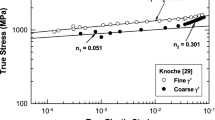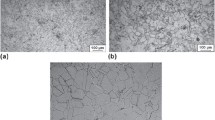Abstract
In this article, a physics-based constitutive model is developed for representing the stress–plastic strain response of Ni-based superalloys by considering the hardening mechanisms that contribute to the macroscopic yield stress and the subsequent strain-hardening response in order to derive the entire tensile stress–strain curve. It is demonstrated that the log stress vs log plastic strain curves of Ni-based superalloys such as 702 Li and ME3 exhibit a bilinear behavior with a lower strain-hardening exponent in the low plastic strain regime and a much higher strain-hardening exponent in the high plastic strain regime. These two hardening regimes can be modeled on the basis of self-hardening of individual slip planes and latent hardening of five operative independent slip systems due to cross-slip from {111} planes to {001} planes, leading to the formation of incomplete and complete Kear-Wilsdorf locks. The proposed physics-based constitutive model, dubbed as MicroROM, exhibits a form that is similar to the Ramberg–Osgood (RO) constitutive model, which is widely used in structural analyses of engineering designs and components. MicroROM is applied to predict the tensile stress–strain curves of 720 Li and ME3 with either a subsolvus or supersolvus microstructure for temperatures ranging from 24 °C to 815 °C. The agreement is good between model predictions and experiment data from the literature. The sensitivity of the predicted stress–strain response to individual microstructural parameters is highlighted and the relation to individual hardening mechanisms is elucidated.


Experimental data are from Milligan et al.[2]

Experimental data are from Gabb et al.[3]

Experimental data are from Gabb et al.[3]

NASA data are from Gabb et al.[3]

NASA data are from Gabb et al.[3]


NASA data are from Gabb et al.[3]


Similar content being viewed by others
References
R.W. Kozar, A. Suzuki, W.W. Milligan, J.J. Schirra, M.F. Savage, and T.M. Pollock: Metall. Mater. Trans. A, 2009, vol. 40(7), pp. 1588-1603. https://doi.org/10.1007/s11661-009-9858-5
W.W. Milligan, E.L. Orth, J.J. Schirra, and M.F. Savage: Superalloys 2004, TMS (The Minerals, Metals & Materials Society), Warrendale, PA, 2004, pp. 331-339.
T.P. Gabb, J. Telesman, P.T. Kantzos, and K. O’Connor: NASA/TM-2002-211796. NASA Glenn Research Center, Cleveland, OH, 2002.
T.P. Gabb, A. Garg, D.L. Ellis, and K.M. O’Connor: NASA/TM-2004-213066. NASA Glenn Research Center, Cleveland, OH, 2004.
T.P. Gabb, J. Gayda, J. Telesman, and A. Garg: Superalloys 2008, TMS (The Minerals, Metals & Materials Society), Warrendale, PA, 2008, pp. 121-130.
D. Rice, P. Kantzos, B. Hann, J. Neumann, and R. Helmink: Superalloys 2008, TMS (The Minerals, Metals & Materials Society), Warrendale, PA, pp. 139-147.
J. Telesman, P. Kantzos, J. Gayda, P.J. Bonacuse, and A. Prescenzi: Superalloys 2004, TMS (The Minerals, Metals & Materials Society), Warrendale, PA, 2004, pp. 215-224.
W.D. Cao and R. Kennedy: Superalloys 2004, TMS (The Minerals, Metals & Materials Society), Warrendale, PA, 2004, pp. 91-99.
R.L. Kennedy: Superalloys 718, 625, 706 and Derivatives 2005, TMS (The Minerals, Metals & Materials Society), Warrendale, PA, 2005, pp 1-14.
D.P. Pope and S.S. Ezz: Int. Met. Rev., 1984, vol. 29(3), pp. 136-167.
K.J. Hemker, M.J. Mills, and W.D. Nix: J. Mater. Res., 1992, vol. 7(8), pp. 2059-2069.
D. Caillard and V. Paidar: Acta Mater., 1996, vol. 44(7), pp. 2759-2771.
D. Caillard: Acta Mater., 1996, vol. 44(7), pp. 2773-2785.
D. Caillard: Mater. Sci. Eng., A, 2001, vol. 319-321, pp. 74-83.
B.H. Kear and H.G.F. Wilsdorf: Trans. Metall. Soc. AIME, 1962, vol. 224, pp. 382-386.
Y.Q. Sun and P.M. Hazzledine: Philos. Mag. A, 1988, vol. 58(4), pp. 603-618.
M.J. Mills and D.C. Chrzan: Acta Metall. Mater., 1992, vol. 40(11), pp. 3051-3064.
S.S. Ezz and P.B. Hirsch: Philos. Mag. A, 1994, vol. 69(1), pp. 105-127.
T.A. Parthasarathy, S.I. Rao, and D.M. Dimiduk: Superalloys 2004, TMS (The Minerals, Metals & Materials Society), Warrendale, PA, 2004, pp. 887-896.
L. Tabourot, M. Fivel, and E. Rauch: Mater. Sci. Eng., A, 1997, vol. 234-236, pp. 639-642.
E.I. Galindo-Nava, L.D. Connor, and C.M.F. Rae: Acta Mater., 2015, vol. 98, pp. 377-390.
Y.C. Lin, X-M. Chen, D-X. Wen, and M-S. Chen: Comput. Mater. Sci., 2014, vol. 83, pp. 282-289.
W. Ramberg and W.R. Osgood: Technical Note 503: Determination of Stress–strain Curves by Three Parameters, National Advisory Committee on Aeronautics (NACA), 1941.
M.P. Jackson and R.C. Reed: Mater. Sci. Eng., A, 1999, vol. 259, pp. 85-97.
K. Gopinath, A.K. Gogia, S.V. Kamat, B. Balamuralikrishnan, and U. Ramamurty: Metall. Mater. Trans. A, 2008, vol. 39(10), pp. 340-2350.
A. Korner: Philos. Mag. Lett., 1989, vol. 60(3), pp. 103-110.
A. Korner: Philos. Mag. A, 1991, vol. 63(3), pp. 407-421.
E. Nadgornyi: Prog. Mater. Sci., 1988, vol. 31, pp. 493-505.
J.F.W. Bishop and R.A. Hill: Philos. Mag., 1951, vol. 42(327), pp. 414-427.
G.I. Taylor: Proc. R. Soc. London, 1934, vol. A145, pp. 362-387.
E. Voce: J. Inst. Met., 1948, vol. 74, pp. 537-562.
H. Mecking and Y. Estrin: Microstructure-related Constitutive Modelling of Plastic Deformation, Eighth International Symposium on Metallurgy and Material Science, Riso, Denmark, 1987.
Integrated Materials and Manufacturing Component Analysis for Life Management (IMCALM) Program, US Air Force Metal Affordability Initiative (Agreement Order No. FA8650-14-2-5211A0#40), Air Force Research Laboratory, Wright-Patterson AFB, Dayton, OH. Dr. Patrick Golden, Program Manager.
R. Madec, B. Devincre, and L.P. Kubin: Phys. Rev. Lett., 2002, 89(25), 25-33.
B. Devincre, L. Kubin, and T. Hoc: Scr. Mater., 2006, vol. 54, pp. 741-746.
D.M. Collins and H.J. Stone: Int. J. Plast., 2014, vol. 54, pp. 96-112.
D. Kuhlmann-Wilsdorf: Metall. Trans. A, 1985, vol. 16(12), pp. 2091-2108.
A. Vinogradov, I.S. Yasnikov, H. Matsuyama, M. Uchida, Y. Kaneko, and Y. Estrin: Acta Mater., 2016, vol. 106, pp. 295-303.
F.C. Frank and W.T. Read: Phys. Rev., 1950, vol. 79, pp. 722-723.
A. Staroselsky and B.N. Cassenti: Mech. Mater., 2010, vol. 42, pp. 945-959.
E.O. Hall: Proc. Phys. Soc., Section B, 1951, vol. 64B(9), pp. 742-747.
N.J. Petch: J. Iron Steel Inst., 1953, vol. 174, pp. 25-28.
L.A. Gypen and A. Deruyttere: J. Mater. Sci., 1977, vol. 12, pp. 1028-1033.
W. Huther and B. Reppich: Z. Metallkd., 1978, vol. 69(10), pp. 628-634.
Acknowledgments
This work was supported by DARPA through Contract Number HR0011-13-C-008 (Jan Vandenbrande, Program Manager). The views, opinions, and/or findings expressed are those of the author and should not be interpreted as representing the official views or policies of the Department of Defense or the U.S. Government. The author acknowledges the assistance by Dr. John McFarland, SwRI, in performing the sensitivity analyses, and Ms. Loretta Mesa, SwRI, in the preparation of the manuscript.
Author information
Authors and Affiliations
Corresponding author
Additional information
Manuscript submitted April 3, 2018.
Distribution A: Approved for public release, distribution unlimited.
Appendix A
Appendix A
This appendix highlights the six yield stress components that are comprised in the yield stress model of Kozar et al. Some of the terms are slightly different from those reported by Kozar et al.[1]
-
1.
Hall–Petch hardening[41,42] of the γ matrix
$$ \Delta \sigma_{1} = f_{m} \left[ {\sigma_{o} + k_{y} d_{m}^{ - 0.5} } \right], $$(A1)where fm is the volume fraction and dm is the average diameter of the γ grains, respectively; so is the friction stress and ky is the Hall–Petch coefficient of the γ-matrix.
-
2.
Solid solution strengthening of the γ matrix[43]
$$ \Delta \sigma_{2} = f_{\text{m}} \Delta \sigma_{\text{ss}} \exp \left( { - {\beta_{1}} T} \right) $$(A2)with
$$ \Delta \sigma_{\text{ss}} \, = \,\sum\limits_{i} {s_{i} \sqrt {C_{i} } }, $$(A3)where si and Ci are the strengthening coefficient and concentration of the ith solid solution element in the γ matrix.[43]. In Eq. (A2), β1 is a constant.
-
3.
Hall–Petch hardening[41,42] of the primary γ′ precipitates
$$ \Delta \sigma_{3} \, = \;f_{1} \left[ {\sigma_{\text{ogp}} + k_{\text{yp}} d_{1}^{ - 0.5} } \right], $$(A4)where σogp is the friction stress and kyp is the Hall–Petch coefficient of the primary γ′.
-
4.
Solid strengthening and anomalous hardening of γ′ precipitates[1]
$$ \Delta \sigma_{4} = \left( {f_{1} + f_{2} } \right)\left[ {\Delta \sigma_{\text{gp}} + q_{1} T + q_{2} T^{2} + q_{3} T^{3} + q_{4} T^{4} } \right] $$(A5)with
$$ \Delta \sigma_{\text{gp}} \, = \,\sum\limits_{i} {s_{\text{gi}} \sqrt {C_{\text{gi}} } }, $$(A6)where sgi and Cgi are the strengthening coefficient and concentration of the ith solid solution element in the γ′. The qi are empirical constants obtained by fitting to the yield strength of γ′, as a function of temperature. Tertiary γ′ precipitates are not included in this term because they are small and are easily sheared with the presence of cross-slip on (001) planes and the formation of K-W locks.
-
5.
Shearing of tertiary γ′ by weak-pair coupling mechanism[44]
$$ \Delta \sigma_{5} = M\left( {\frac{{\gamma_{\text{APB}} }}{2b}} \right)\left[ {\sqrt {\frac{{\gamma_{\text{APB}} d_{3} }}{{2T_{\text{L}} }}} \left( {\frac{{d_{3} }}{{L_{\text{s}} }}} \right) - \frac{\pi }{4}\left( {\frac{{d_{3} }}{L}} \right)^{2} } \right], $$(A7)where M is the Taylor factor, TL is the line tension, L is the center and center particle spacing, and Ls is the mean planar spacing. L, Ls, and TL are given by Eqs. [5a], [5b], and [11] in Kozar et al.[1]
-
6.
Shearing of secondary γ′ by strong-pair coupling mechanism[44]
$$ \Delta \sigma_{6} = M\left( {\frac{{2T_{L} }}{{\pi bL_{x} }}} \right)\left[ {\frac{{\pi d_{2} \gamma_{APB} }}{{2T_{L} }} - 1} \right]^{1/2}, $$(A8)where Lx is the strong-pair particle spacing given by Eq. [13] in Kozar et al.[1]
Rights and permissions
About this article
Cite this article
Chan, K.S. MicroROM: A Physics-Based Constitutive Model for Ni-Based Superalloys. Metall Mater Trans A 49, 5353–5367 (2018). https://doi.org/10.1007/s11661-018-4878-7
Received:
Published:
Issue Date:
DOI: https://doi.org/10.1007/s11661-018-4878-7








